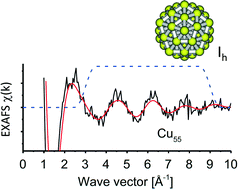Structural investigation of supported Cun clusters under vacuum and ambient air conditions using EXAFS spectroscopy
Abstract
Extended X-ray absorption fine structure (EXAFS) measurements have been carried out to explore the size-dependent structure of deposited Cun clusters using the element-specific Kα fluorescence signal of copper. In particular, Cu55 and Cu35 have been deposited on a thin natural silica layer of a Si(100) wafer and have been investigated under both ultra-high vacuum and ambient air conditions. Pieces of evidence of an icosahedral structure of Cu55 and a densely-packed compact fcc-like geometry of Cu35 are concluded from a comparison of the magnitude EXAFS spectra and FEFF simulations of the geometry of the corresponding free clusters. The exceedingly small radial distances as revealed from the radial distribution plots of the pristine clusters can be explained by a severe increase (∼100%) in the scattering phase shift with respect to that of copper bulk. After exposure to ambient atmosphere, the EXAFS signal of “magic” Cu55 as well as that of Cu35 exhibits oxidation of the clusters showing a nearest-neighbour radial distance peak which agrees with the Cu–O bond length in amorphous copper hydroxide.

- This article is part of the themed collection: Nanocatalysis

 Please wait while we load your content...
Please wait while we load your content...